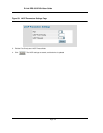
D-Link DES-3010FA/GA User Guide
Page 102
Section 8. Aggregating Ports
Link Aggregation optimizes port usage by linking a group of ports together to form a single LAG (aggregated
group). Aggregating ports multiplies the bandwidth between the devices, increases port flexibility, and provides
link redundancy.
The device supports both static LAGs and Link Aggregation Control Protocol (LACP) LAGs. LACP LAGs negotiate
aggregating ports’ links with other LACP ports located on a different device. If the other device ports are also
LACP ports, the devices establish a LAG between them.
• Consider the following when aggregating ports:
• All ports within a LAG must be the same media type.
• A VLAN is not configured on the port.
• The port is not assigned to a different LAG.
• Auto-negotiation mode is not configured on the port.
• The port is in full-duplex mode.
• All ports in the LAG have the same ingress filtering and tagged modes.
• All ports in the LAG have the same back pressure and flow control modes.
• All ports in the LAG have the same priority.
• All ports in the LAG have the same transceiver type.
• The device supports up to eight LAGs, and eight ports in each LAG.
• Ports can be configured as LACP ports only if the ports are not part of a previously configured LAG.
• Ports added to a LAG lose their individual port configuration. When ports are removed from the LAG, the orig-
inal port configuration is applied to the ports.
The device uses a hash function to determine which packets are carried on which aggregated-link member. The
hash function statistically load-balances the aggregated link members. The device considers an Aggregated Link
a single logical port. This section contains the following topics:
• Aggregating Ports
• Configuring LACP


















